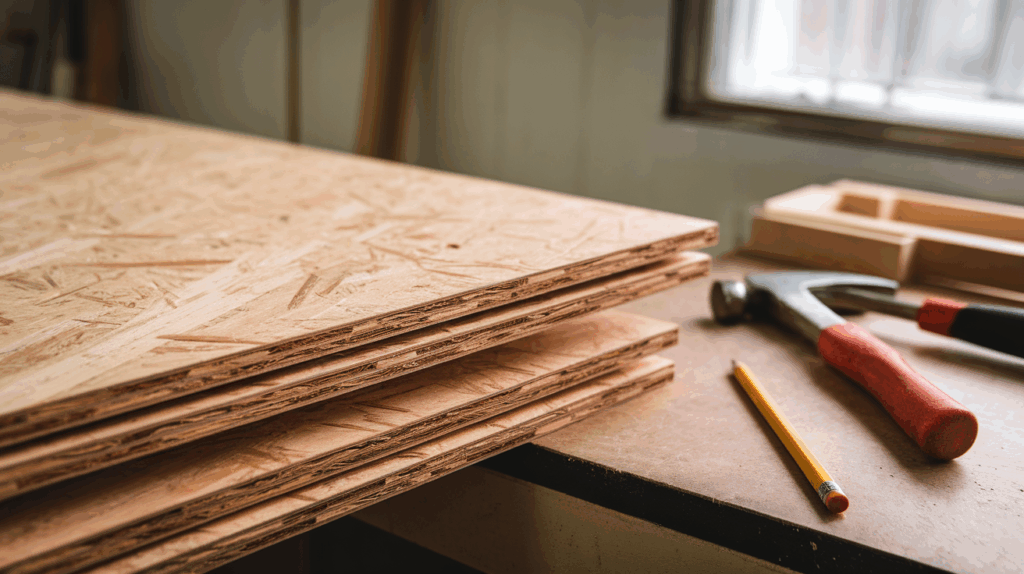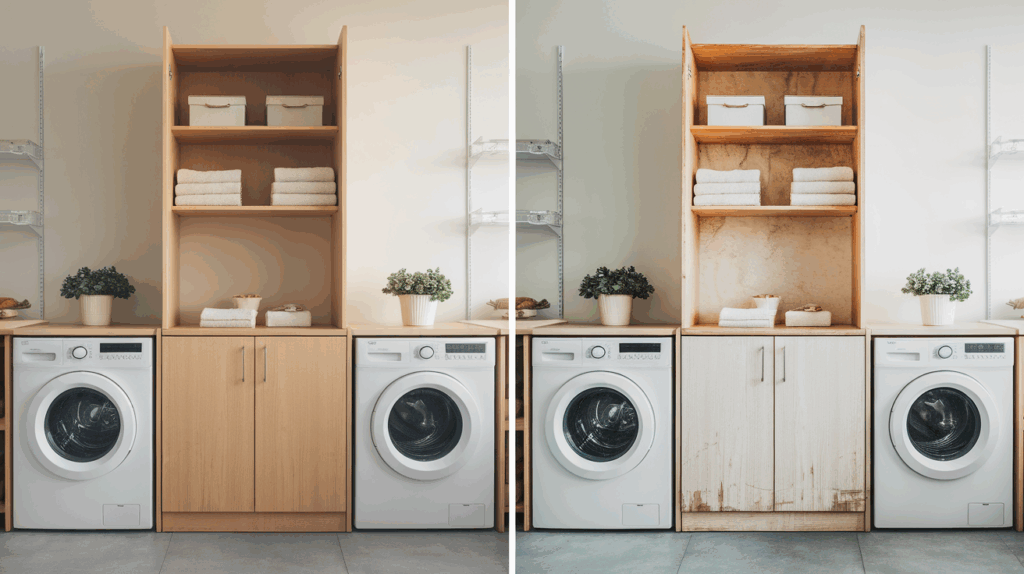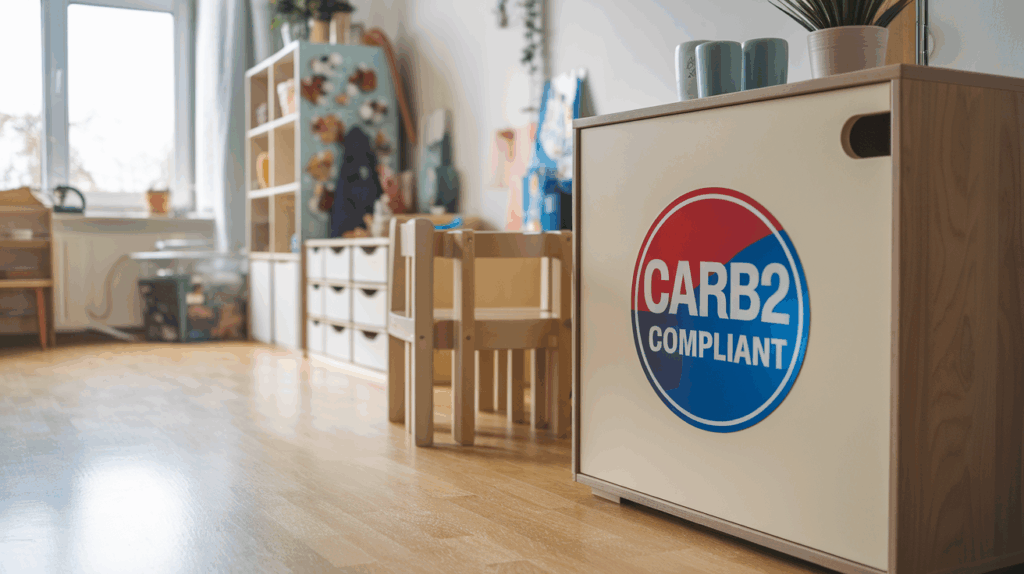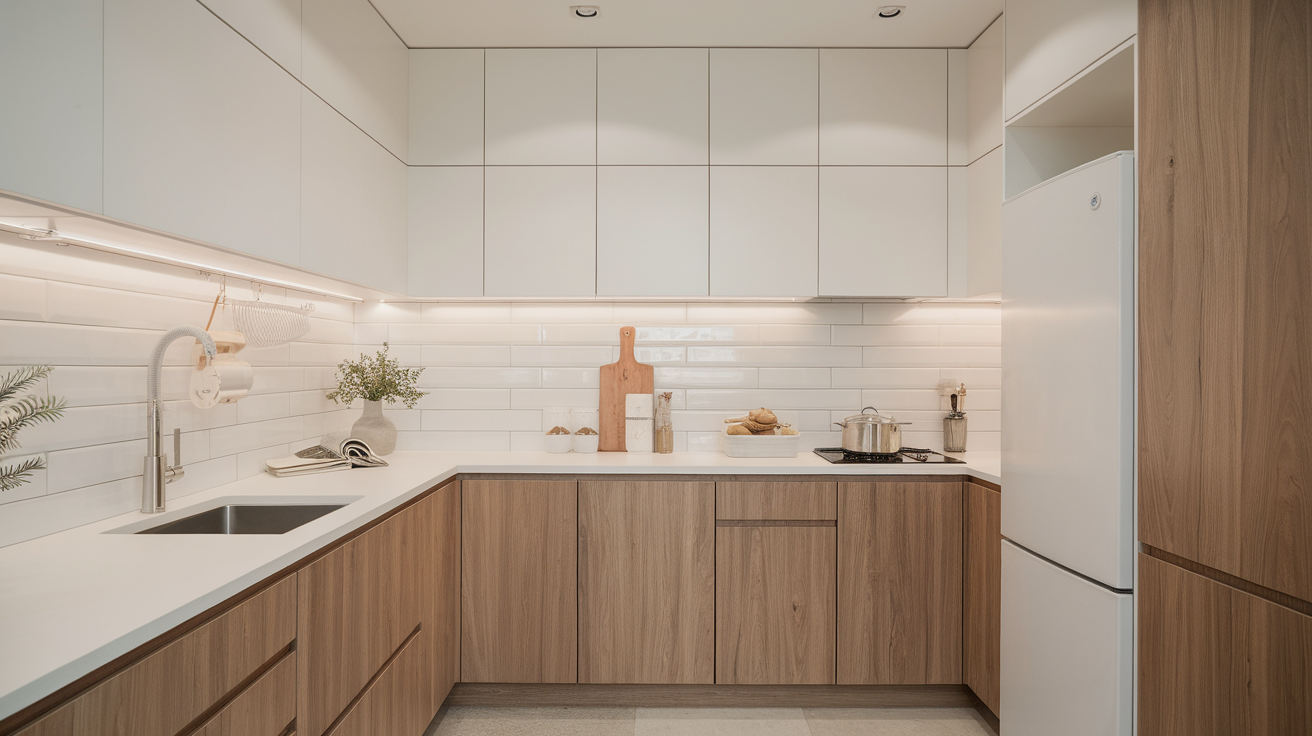Creating a kitchen, bathroom, or garage setup on a budget isn’t easy, but I’ve found that particleboard cabinets help you get the job done without draining your wallet.
These cabinets are popular for a reason: they’re affordable and easy to customize.
However, they come with trade-offs as well, especially when it comes to moisture and long-term strength.
If you’re trying to decide if they’re right for you, I’ll walk you through what they’re made of, their pros and cons, how long they last, and where they make the most sense in your home.
What Are Particleboard Cabinets?

Particleboard cabinets are made from wood chips, sawdust, and resin pressed into sheets.
Instead of using solid wood, I get a product that’s dense, flat, and easy to cut and cover with laminate or veneer. This gives me a clean finish without the high cost of solid hardwood or even plywood.
The surface stays smooth and works well with paints, vinyl wraps, and decorative foils. I’ve seen them used in budget kitchen setups, laundry rooms, rental units, and even commercial office cabinetry.
You’ve probably walked past particle board cabinets at a big-box furniture store without realizing it; they look the part, but cost way less.
If you’re buying ready-to-assemble cabinets, chances are they’re made of particleboard with a thin laminate skin. The key is knowing the material beneath the finish.
Pros of Particle Board Cabinets
This is what I like about particleboard cabinets when I need to balance function with cost:
- Lower Price: They cost much less than solid wood or even plywood, which keeps my budget in check. I’ve been able to remodel an entire laundry room or pantry without breaking the bank.
- Smooth Finish: The surface takes well to veneers, laminate, or thermofoil. That means I get that modern, polished look without spending on real wood grain.
- Lightweight Build: I don’t need help moving or lifting them. When I installed a small kitchenette alone, its lightness made it manageable.
- Customizable Designs: They come in tons of finishes, from sleek white to wood-look styles. I’ve matched them with everything from farmhouse-style counters to modern hardware.
- Easy to Find: They’re available at nearly every home improvement store. I don’t have to wait weeks for delivery; if I need them today, I can grab them today.
Cons of Particleboard Cabinets
Even though they’re easy on the wallet, particleboard cabinets have their limitations. Here’s what I always consider before buying:
- Moisture Issues: If water seeps into unsealed edges, they swell and break down. I had a base cabinet near the sink buckle after a minor leak.
- Less Strength: They aren’t great at holding up heavy items. Over time, sagging shelves can become a problem, especially if you load them with pots or cans.
- Shorter Lifespan: They typically last 10 to 15 years, sometimes less in high-use areas. That’s fine for some spaces, but not ideal for forever homes.
- Screw Loosening: Hinges, drawer slides, or handles can come loose because the board doesn’t grip screws tightly. Reinforcing these spots upfront helps, but it’s still a weak point.
- Hard to Repair: You can’t sand and refinish them like solid wood. Chips or bubbling laminate usually mean replacing the whole door or panel.
How Long Do Particle Board Cabinets Last?

Particleboard cabinets can last 10 to 15 years with the right care. Here are some tips to help extend their lifespan:
Typical Lifespan:
- Well-maintained: Can last over a decade, especially in dry areas like laundry rooms.
- Poorly maintained: May fail within a few years due to moisture damage from leaks or poor ventilation.
Moisture Management:
- Seal raw edges to prevent water damage.
- Avoid placing near plumbing fixtures.
- Wipe spills immediately to prevent moisture buildup.
Weight Considerations:
- Avoid overloading with heavy items like dishes or cans.
- Use for lighter items like pantry goods or office supplies to extend the lifespan.
By staying proactive with moisture control and mindful use, you can significantly increase the durability of particleboard cabinets
Where I Use Particle Board Cabinets and Why
I don’t use particleboard cabinets everywhere, but they work great in specific spots where moisture isn’t a huge concern and long-term strength isn’t essential. Look at my my go-to spaces:
- Garage Cabinets: I keep tools and light hardware inside. They help me stay organized without spending a fortune.
- Laundry Room: It’s a low-traffic space, and I keep everything dry, so they hold up just fine.
- Rental Units: For budget remodels, they make sense because they’re affordable and still look clean when finished right.
- Closets or Storage Rooms: I don’t need high-end materials here, just something tidy and functional.
- Basement Bar or Small Office Nook: When moisture isn’t an issue, I use them to create stylish work zones without a big investment.
Are Particleboard Cabinets Safe and Non-Toxic?

When I choose cabinets, I also think about safety, especially in homes with kids or pets.
Most particleboard contains adhesives like formaldehyde, which can release gases over time. I always check for low-emission or CARB2-compliant labels to reduce exposure.
Many manufacturers now offer eco-friendlier options that meet strict indoor air quality standards.
If you’re concerned about toxins, it’s worth looking into the materials and finishes used. You can still go budget-friendly while making safer choices for your home.
How to Care for Particleboard Cabinets?
Caring for particleboard cabinets involves a few simple steps that can significantly extend their lifespan. Start by sealing any exposed edges with edge banding or paint to protect them from moisture.
Regular cleaning with a soft cloth and mild cleaner will prevent dirt buildup and keep them looking fresh. Avoid overloading shelves to prevent sagging, and consider adding brackets for extra support.
If you notice any chips or swelling, address them quickly with wood filler and sealant.
Additionally, ensure proper ventilation in areas prone to humidity, like bathrooms or laundry rooms, to prevent moisture damage.
Tips to Make Particle Board Cabinets Last Longer
If you’re set on using them, below are the steps I take to make sure they last as long as possible:
- Seal All Edges: Use edge banding or a couple of coats of paint to block moisture from getting in. I especially focus on the bottom edges and around cutouts for pipes.
- Add Soft-Close Hardware: Soft-close hinges and slides reduce impact. I’ve had fewer issues with screws loosening when I upgrade the hardware right away.
- Don’t Overload Shelves: Particleboard shelves can sag, so I store lighter items and avoid stacking anything too high or heavy.
- Support with Brackets: For longer shelves or wide cabinets, I install metal L-brackets underneath to prevent sagging.
- Check for Chips or Swelling: When I see signs of damage, I act fast. A little wood filler and some sealant can slow the spread of chips or delamination.
- Vent the Room: Good airflow is key. In laundry rooms or basements, I make sure humidity doesn’t build up. Sometimes I add a small fan or dehumidifier to keep things dry.
Conclusion
If you want budget-friendly cabinets and you’re careful with moisture, particleboard can be a smart option.
I use them in parts of my home where style matters but toughness isn’t critical.
They’re light, easy to install, and look clean when finished well. Sure, they don’t last as long or hold weight like plywood or solid wood, but I think they’re worth it in the right setting.
As long as you know what to expect and treat them right, they give you value without stretching your budget, and sometimes that’s exactly what you need.

